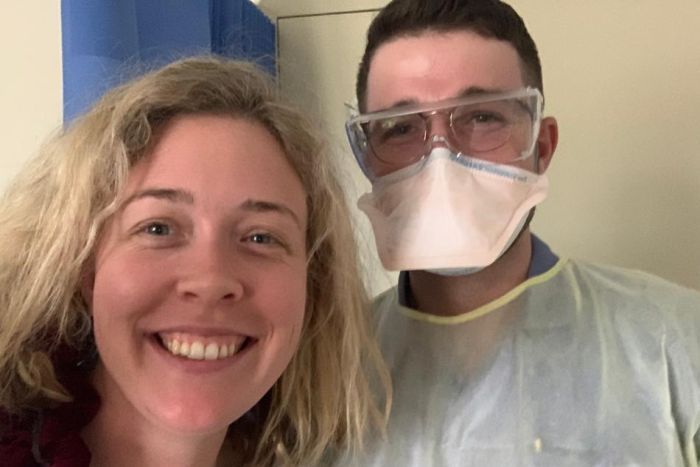WATCH: What is it like to actually have Coronavirus? Australia’s first coronavirus cases tells her story
Share
When Bridget Wilkins flew back to Australia from London earlier this month, she was looking forward to being MC at her best friend’s wedding but she never made it to the ceremony.
Key points:
- Bridget Wilkins was one of Australia’s first diagnosed cases of coronavirus
- She spent almost two weeks in isolation in a Brisbane hospital
- She has now been released from hospital but has low immunity
Australia’s first coronavirus cases tells her story
After she landed, she went to the doctor for a general health check-up and discovered she had coronavirus.
“They said we think we should check you for coronavirus and I said, ‘you’re being ridiculous, I haven’t got coronavirus’,” she told 7.30.
“Turns out they were right and I was wrong.”
No-one knows where she picked up the virus.
“They think it may have been at the airport, whether it’s Heathrow or Singapore … it’s hard to pinpoint at this stage,” she said.
She was one of the first cases of coronavirus diagnosed in Australia and has spent 13 days in isolation at a Brisbane hospital.
“It was quite scary when I got that phone call,” she said.
“I’ll be honest, the first question I asked the doctor on the phone was, am I going to die?”
“Which sounds a bit dramatic but at that stage, two weeks ago, I didn’t really know what coronavirus was.”

Ms Wilkins was taken to hospital to help prevent the spread of the virus.
“It felt like a bit of a con, to be honest, to walk into hospital feeling fairly healthy, yet everyone’s in hazmat suits,” she said.
The initial symptoms were not severe.
“I had things you’d have normally when you have a flu or a cold: sore throat, headache, bit of a chesty cough, but nothing too serious,” she said.
“I had a little bit of a fever, I was a little bit tired.
“So, it was really hard to accept the diagnosis because I didn’t feel physically unwell.”
But then her condition deteriorated.
“I became very, very fatigued and I had quite intense headaches and a level of chest pain,” she said.
The worst period was around days eight to 10.
“I felt like I was 80 years old,” the 29-year-old said.
“I struggled to sit up in bed, to get out of bed, to do all the basic things that we probably all take for granted.”
Infectious diseases expert Dr Sanjaya Senanayake says every successful treatment contributes more knowledge about the virus.
“Her case and all the other cases are really helpful in helping us understand the epidemiology, the clinical features, the immune response to COVID-19,” he told 7.30.
But he insists it is still important to slow the spread of coronavirus.
“In the last few days in Australia, we’ve seen the number of cases rise,” Dr Senanayake said.
“Given that the curve is going up, it is really important that the social-distancing measures that have been talked about nationally at a federal, state and territory level are enforced to try and flatten that curve and get control of the outbreak.”
Recovery and beyond
Towards the end of her isolation, Ms Wilkins told doctors she was feeling a lot better and would be happy to remain in isolation at home to free up the bed for others.
But she was told she could not be released until she had returned two negative swabs in a row.
On day 13, she received that second negative and was free to go.
“Now I have no coronavirus in my system,” Ms Wilkins said.
“I’m not infectious and I’m not contagious according to medical advice, which is nice.
“But what I do have is a low immune system.”
Having been through the ordeal, she now admits to having a little fear about what happens next.
“It’s a long time to be in one space, physically and mentally,” she said.
“It’s actually quite daunting because you don’t really know where you’re going to begin, what you’re going to do.
“No-one talks about the end — not with coronavirus. They only talk about the beginning.”
She hopes that sharing her experience with the illness will help inform others.
“I think all we can do is tell our stories and share facts, share knowns, share expectations,” she said.
“So we can reduce the level of fear in the world and replace it with understanding, compassion and with love. And I hope I can do that.”
Story from ABC News






